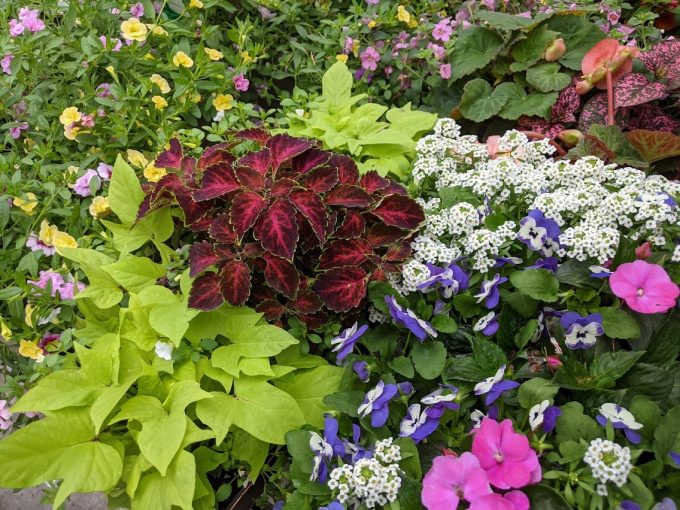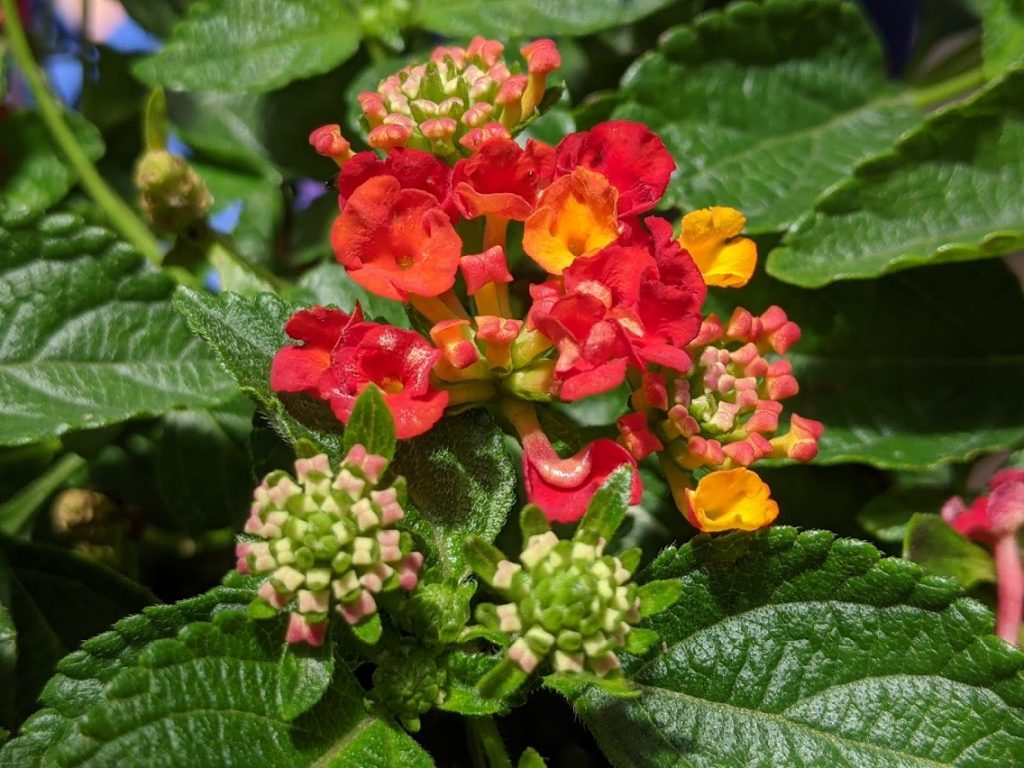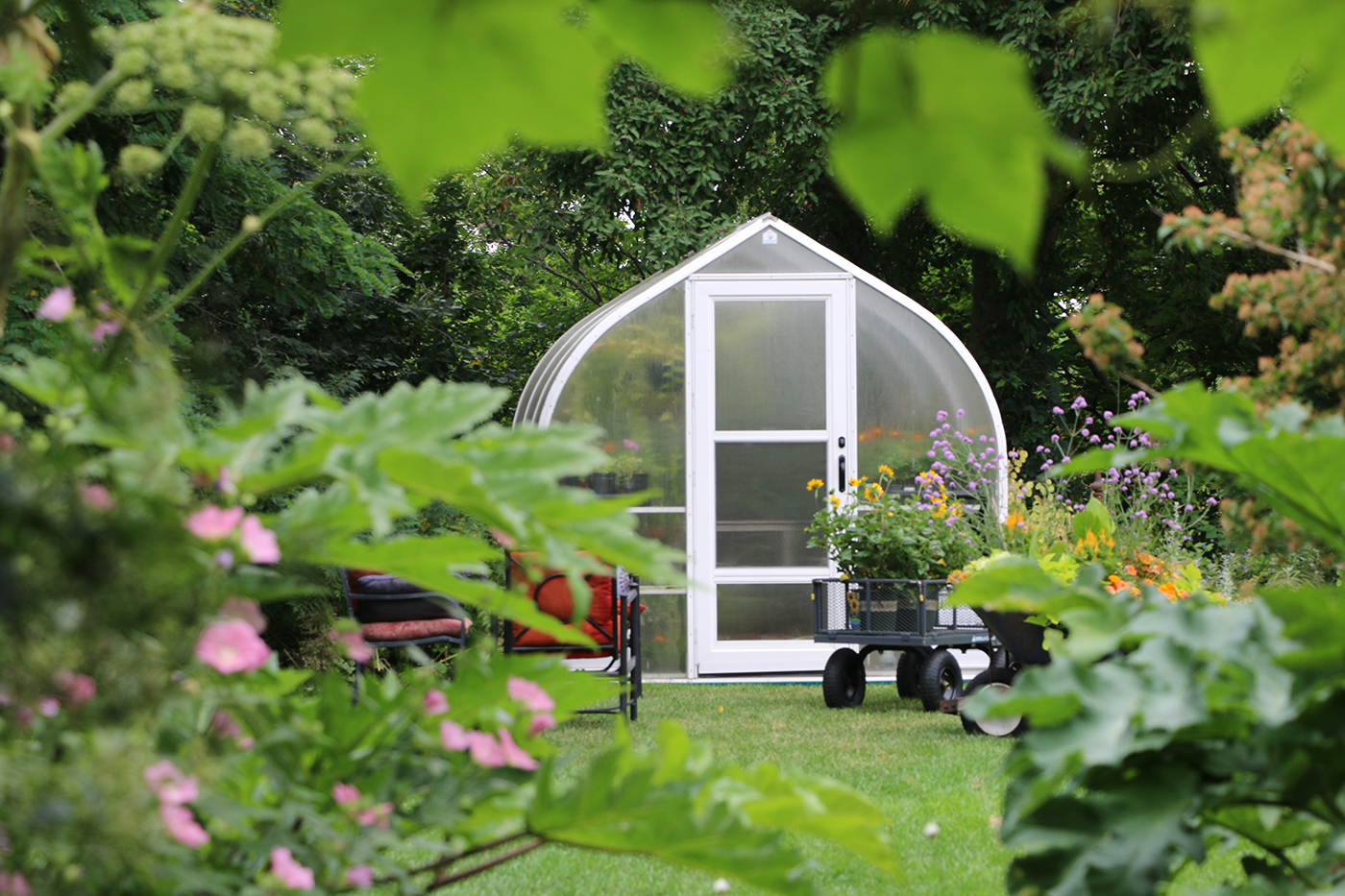There’s no denying that petunias and geraniums are real workhorses in an annual bed or container… tough and beautiful at the same time. But I wanted to know what members of the Tagawa’s Annuals crew took home for their own gardens other than these two tried and true plants.
I asked six of the folks on our annuals team and for the most part, got strikingly answers. Let’s take a quick look at what some of them had to say. And for the record, not one of them had to think twice!
Jere is Tagawa’s Annuals and Production Dept. Manager
Our lovely Jere is one of the nicest people you’ll ever meet, and a wealth of gardening information, too. Even though she herself is routinely camera-shy, she didn’t miss a beat in directing me to two of her favorite summer annuals so I could show them off to you.
“Misty” salvia
Jere loves blue in the garden. She says Misty salvia really delivers!
Misty salvia can take full sun to part shade and makes a great “thriller,” the central and usually tallest component of many container gardens. It’s also great along borders and in beds. And where heat’s concerned, “Misty” says bring it on!
Jere plants this salvia with another heat-lover, white “Sorena” angelonia.
She says the contrast between the blue and white is stunning! Angelonia also comes in lavender and pink. Jere’s so fond of it, she uses it liberally in full-sun plantings that Tagawa’s puts in at UCHealth Training Center.
Angelonia is low-maintenance and sends up delicate-looking (but tough) flower spikes all summer long, and the honey bees love it!
Deborah is Tagawa’s Annuals Dept. Supervisor
Like Jere, our Deborah can sometimes be a bit camera shy. But one thing she does love is snapdragons, any kind, and any color, but especially the tall “Rocket” types in mixed hues of yellow, pink, burgundy, and white.
Deborah’s affection for this old-fashioned flower was a delight to hear, and a bit surprising. With so many options on display at Tagawa’s, a salute to our grandparents’ summer if gardens seemed so sweet!
Deborah plants snaps when the weather is still cool and uncertain (sound familiar?). She says once the first long flush of blossoms fades, she cuts the spikes back to the ground and waits for the second round of flowers in mid-summer and beyond.
Deborah says if you love these flowers the way she does, wait for the seed pods on the snapdragons to dry completely, then press them open and scatter the seed to get more flowers next season.
And if you have little kiddos around, let them pluck a blossom, squeeze it, and make it “roar!” What fun!
Kristy, our Annuals Floor Supervisor, is a very familiar face in Tagawa’s Annuals Department
Even with a mask on, Kristy is easy to spot, zooming around her much-loved annuals like the busy bee she is.
“Cuphea” or “Cigar plant” is her go-to annual. This plant is also called “Vermillionaire.” A lot of folks are just now discovering Cuphea, and Kristy says it’s about time!
One look at cuphea’s odd little flowers and it’s easy to see why it’s also known as “the cigar plant.” Kristy says she loves that cuphea’s little tubular flowers draw in lots of hummingbirds and never need dead-heading, the routine removal of blossoms that are fading. She says cuphea blooms all summer long and adds nice height in the garden.
“Amistad” salvia is also very high on Kristy’s list of favorite annuals. She uses it as a thriller to add height to flower containers.
These rich densely purple flower spikes are a bee magnet, even though the flowers are red. It’s the tubular shape of the blossoms as much or more than the color that attracts the bees. Kristy says Amistad rarely needs dead-heading.
Hint: Plants with aromatic foliage like this and other salvias, lavender, and most herbs are usually passed over by browsing bunnies and deer. Rub a plant’s leaves gently, then smell your fingers. If there’s a strong fragrance left from the foliage, that plant will likely be rabbit and deer resistant. But for the record, the only deer-proof plants are those inside a six-foot or taller fence. Just sayin’…
Trisha is Tagawa’s Annuals/Production Administrative Assistant
If you love purple flowers (and I do!), Trisha’s first choice will be a keeper! Take a look at lobularia “Purple Stream.”
This lovely plant puts out mounding clumps of oh-so tiny blossoms. The plants are great for around the edge of a large mixed container of annuals. This type of lobularia is heat-tolerant but does need to be kept evenly moist to keep the flowers coming.
Trisha cautions that she does watch closely for pesky very tiny insects called “flea beetles” that like to prey on young lobularia. She fights back with “Captain Jack’s Dead Bug Brew” if the beetles become a real problem.
And then there’s “Mezoo” or “Livingston daisy,” another of Trisha’s go-to annuals. This little plant may surprise you!
Mezoo is a succulent with tiny, slightly leathery pale green leaves with white edges. It will pop out little marble-sized magenta flowers which give its alternate name of Livingston daisy.
But just look what this small but mighty plant does in Trisha’s big flower pot!
Mezoo can be a roundy-moundy spiller as it is here in the lower right of Trisha’s big beautiful planting. It can also drape down the side of the pot a foot or more. It’s quite the plant!
Mezoo will be right at home in hot sunny locations. It blooms all summer, and given bright light, may even survive as a houseplant over the winter.
Cindy’s favorite annuals are red and hot!
Cindy works around flowers of every color and description when she’s in Tagawa’s annuals department, but the plants she takes home need to pop!
Her favorite pairing starts with “Hot Blooded” lantana. She says she loves the way Hot Blooded makes such a statement, shouting out from a distance. It’s a plant that simply refuses to be ignored!
Cindy says lantana in general is a very tough, easy-care plant, blooming all summer long. She surrounds her Hot Blooded lantana with a fiery red portulaca, or moss rose.
Portulaca is a low-growing succulent that needs very well-draining soil. She describes the flowers on this reddish-orange plant as “garden glitter,” showing off all season long.
Mary Anne has a shade-loving favorite
Like the others I questioned for this little survey, Mary Anne knew exactly what plant she’d recommend: beautiful blue torenia.
This is also known as “wishbone flower,” and one close look at the blossoms tells you why. See the tiny wishbone pattern in the white throat at the middle of the blossom?
Torenia prefers morning sun or full shade. Mary Anne says it should be grown with even moisture in well-draining soil. The cool blue of torenia can add a sweet and calming feeling to a shady spot on your deck or patio.
Don’t forget to fertilize!
A lot of annuals enthusiasts seem to forget that these plants need lots of nutrients… consistent feeding throughout the summer… to keep pushing out the flowers that we crave, so don’t skimp on fertilization.
All of the folks I spoke with feed their plants weekly, no exceptions! Most of them feed at half-strength with their favorite fertilizers, all of which we carry at Tagawa’s.
Hope this inspires you to check out some annuals you’ve never tried before! Wishing you a summer-long display of beautiful flowers!


















